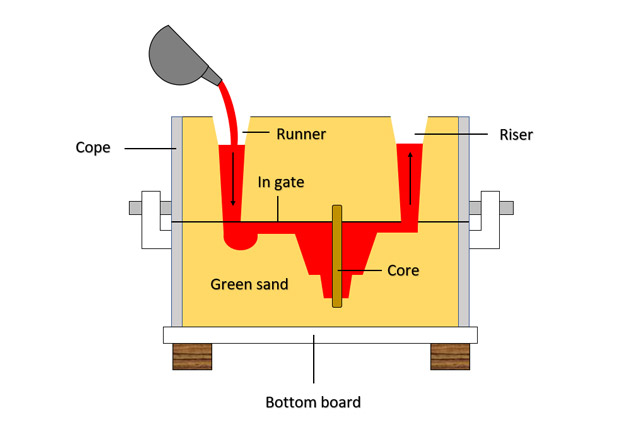Not known Facts About Stahl Specialty Company
Not known Facts About Stahl Specialty Company
Blog Article
Some Known Incorrect Statements About Stahl Specialty Company
Table of ContentsNot known Facts About Stahl Specialty CompanySome Ideas on Stahl Specialty Company You Need To KnowSome Known Questions About Stahl Specialty Company.The Main Principles Of Stahl Specialty Company Facts About Stahl Specialty Company Revealed
Chemical Comparison of Cast Aluminum Alloys Silicon promotes castability by lowering the alloy's melting temperature level and improving fluidity during spreading. Furthermore, silicon contributes to the alloy's strength and wear resistance, making it beneficial in applications where toughness is vital, such as automotive components and engine parts.It also boosts the machinability of the alloy, making it much easier to process right into completed items. By doing this, iron adds to the general workability of light weight aluminum alloys. Copper enhances electric conductivity, making it beneficial in electric applications. It also improves deterioration resistance and contributes to the alloy's overall toughness.
Manganese adds to the toughness of aluminum alloys and enhances workability. It is generally utilized in functioned aluminum products like sheets, extrusions, and profiles. The visibility of manganese help in the alloy's formability and resistance to breaking during construction processes. Magnesium is a lightweight aspect that supplies toughness and effect resistance to light weight aluminum alloys.
Zinc improves the castability of aluminum alloys and assists control the solidification process during casting. It boosts the alloy's strength and firmness.
Fascination About Stahl Specialty Company
Since aluminum-silicon alloys have excellent spreading residential properties, high gas properties, simple processes, and superb rust resistance, aluminum-silicon alloys are most commonly made use of in the die-casting market at home and abroad. At the same time, aluminum-silicon alloys are also relatively early and extensively identified alloys established and utilized in die-casting. After continual research study and improvement, the majority of the existing worldwide mainstream aluminum-silicon alloys have actually been wrapped up and are absolutely nothing more than A356, A360, A380, ADC12, B390, and A413.
The primary thermal conductivity, tensile toughness, yield strength, and elongation vary. Among the above alloys, A356 has the highest thermal conductivity, and A380 and ADC12 have the least expensive.

How Stahl Specialty Company can Save You Time, Stress, and Money.
In accuracy spreading, 6063 is well-suited for applications where elaborate geometries and high-grade surface finishes are extremely important. Examples include telecommunication units, where the alloy's exceptional formability enables sleek and visually pleasing styles while maintaining architectural stability. In the Lighting Solutions industry, precision-cast 6063 components create stylish and effective illumination components that call for complex forms and excellent thermal efficiency.
(https://lnk.pblc.app/pub/4920c349338804)
The A360 displays superior elongation, making it suitable for complex and thin-walled elements. In accuracy spreading applications, A360 is well-suited for markets such as Customer Electronics, Telecommunication, and Power Tools.

In precision casting, light weight aluminum 413 radiates in the Customer Electronics and Power Equipment sectors. This alloy's exceptional deterioration resistance makes it an excellent option for exterior applications, guaranteeing resilient, durable products in the pointed out sectors.
Not known Factual Statements About Stahl Specialty Company
The aluminum alloy you choose will substantially affect both the casting process and the buildings of the site last product. Because of this, you must make your choice very carefully and take an informed approach.
Establishing the most appropriate light weight aluminum alloy for your application will suggest evaluating a wide variety of characteristics. The very first category addresses alloy attributes that affect the manufacturing procedure.
The alloy you choose for die spreading straight affects numerous aspects of the casting procedure, like exactly how easy the alloy is to function with and if it is prone to casting flaws. Warm breaking, likewise referred to as solidification breaking, is a normal die spreading problem for light weight aluminum alloys that can cause internal or surface-level splits or fractures.
Stahl Specialty Company for Beginners
Certain aluminum alloys are much more prone to warm splitting than others, and your choice must consider this. Another usual issue located in the die spreading of light weight aluminum is pass away soldering, which is when the actors stays with the die wall surfaces and makes ejection tough. It can damage both the cast and the die, so you ought to search for alloys with high anti-soldering residential properties.
Corrosion resistance, which is already a remarkable feature of light weight aluminum, can differ substantially from alloy to alloy and is an essential particular to take into consideration depending upon the environmental problems your product will certainly be subjected to. Use resistance is another residential or commercial property frequently sought in aluminum items and can distinguish some alloys.
Report this page